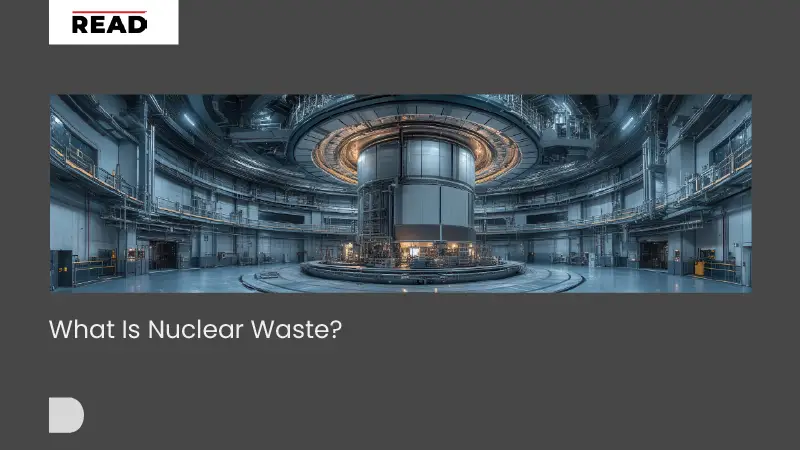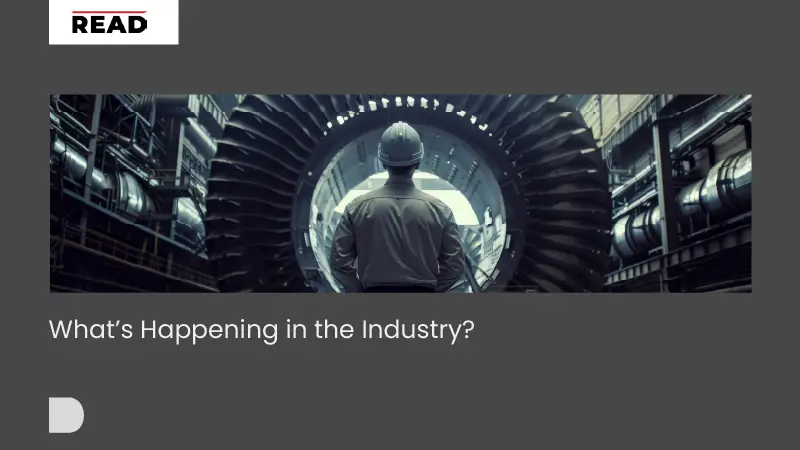Nuclear energy powers many parts of the world. It is clean and reliable. But it also creates nuclear waste. That waste is dangerous and needs careful handling.
Industrial partners, from contractors to tech providers, play a big role in managing this waste. Let’s look at what nuclear waste management really means for them, with some real numbers to show just how important this work is.
What Is Nuclear Waste?

When a nuclear power plant runs, it uses fuel made from uranium. Over time, that fuel gets used up and turns into waste.
This waste comes in three main types:
- Low-level waste includes low-risk materials, clothing, and tools.
- Radioactive sludge and reactor components are examples of intermediate-level waste.
- Used nuclear fuel is considered high-level waste. It needs to be stored properly because it is very radioactive.
There are currently approximately 390,000 metric tons of spent nuclear fuel in the world, and we are adding 12,000 tons annually.
One of the main issues facing the nuclear industry is the safe management of this waste.
Also Read: What Is Stationary Power Generation? A Complete Overview for Energy Tech Leaders
Why Does It Matter to Industrial Partners?
Many companies build and run nuclear power plants. These companies are part of a bigger system called the energy supply chain. When it comes to nuclear waste, they’re involved in many ways.
Here’s how:
1. Designing Safer Equipment
Companies that make containers, pipes or storage systems have to follow strict rules. Nuclear waste can’t leak or get exposed. So, the parts used to move or store waste must be strong and safe.
Even the smallest mistake can cause big problems. That’s why design and testing are so important.
For example, Sweden is building a deep underground storage site that will safely store 12,000 tons of nuclear waste for 100,000 years. It’s expected to cost over US$ 1.08 billion.
The design includes copper canisters, bentonite clay layers, and reinforced tunnels to prevent leaks.
2. Transporting Waste Safely
Some companies help move nuclear waste from one place to another. This could be from the reactor to a temporary storage site. Or to a place where the waste will stay for a very long time.
Transporting radioactive materials needs special vehicles and strict procedures. Industrial partners involved in transport must be well-trained and follow safety rules closely.
The U.S. alone has over 92,500 metric tons of spent fuel stored at reactor sites, and adds around 2,000 tons every year.
These materials are stored in large steel and concrete casks. Mostly right next to the reactors. This is because of the lack of centralized storage.
3. Helping with Long-Term Storage
High-level waste needs to be stored deep underground. Some companies are helping build these deep storage sites.
This work involves:
- Digging tunnels
- Creating sealed containers
- Monitoring for leaks
The U.K.’s Sellafield site, one of the world’s largest nuclear waste locations, is expected to manage 1.8 million tonnes of nuclear waste over the next 120 years.
In Finland, the Onkalo facility, the world’s first permanent deep geological repository, is nearly complete. It will house waste 500 meters underground, in rock believed to remain stable for thousands of years.
4. Cleaning Up Old Sites
When a nuclear plant shuts down, it doesn’t just disappear. There’s still a lot of work to do. The site needs to be cleaned up, and the waste needs to be removed.
Industrial partners help with:
- Breaking down old equipment
- Packing up waste safely
- Restoring the land afterward
This process is called decommissioning.
In the US, Hanford has over 56 million gallons of radioactive waste. The cleanup will cost US$ 300 billion to US$ 640 billion and take decades to finish.
Germany plans to spend over €18 billion decommissioning its nuclear plants. That figure doesn’t include long-term waste storage costs.
5. Using Technology for Monitoring
New technology is making nuclear waste management smarter. Some companies now use:
- Sensors to check for leaks
- Robots to handle waste in dangerous areas
- Digital systems to track where waste is stored
These tools help reduce risks and make the work safer for everyone involved.
Drones and automated systems also reduce human exposure in high-risk zones. At Sellafield, robotic arms are being used to sort and pack waste.
6. Working with Rules and Regulations
Handling nuclear waste comes with a lot of rules. These rules are made to protect workers, the public, and the environment.
Industrial partners must know these rules and follow them. If they don’t, it can cause delays or serious safety issues.
In fact, many nuclear decommissioning projects have faced budget and time issues. One study found that costs ran over by up to 202%, and delays were more than 104%.
That’s why compliance, staff training, and documentation are essential.
What’s Happening in the Industry?
 Moltex Energy Canada Inc. (Moltex) is disrupting nuclear waste management with its Waste to Stable Salt (WATSS) technology. This game changing technology will solve the nuclear industry’s biggest problem as it responds to growing global demand.
Moltex Energy Canada Inc. (Moltex) is disrupting nuclear waste management with its Waste to Stable Salt (WATSS) technology. This game changing technology will solve the nuclear industry’s biggest problem as it responds to growing global demand.
Moltex has validated WATSS on used fuel bundles from a commercial reactor in Canada through hot cell experiments executed by Canadian Nuclear Laboratories, a major milestone in closing the nuclear fuel cycle and next generation nuclear sustainability.
WATSS converts used nuclear fuel into an asset in 24 hours. Moltex has shown it can extract 90% of the transuranic material in 24 hours, more efficiently over longer periods of time.
This reduces nuclear waste volumes by a huge amount and opens up new economic opportunities for waste owners and utilities, options previously impossible because of cost and lack of waste management capacity as nuclear becomes a bigger part of the global energy mix. With 66 reactors under construction and over 80 SMR designs in development worldwide WATSS is a financially viable way to manage more waste more sustainably.
The Bigger Picture
Nuclear will grow. Many countries are turning to it as a cleaner way to produce energy and cut carbon emissions. But more nuclear means more nuclear waste.
Today, over 30 countries operate nuclear power plants. Dozens more will build their first reactors in the next few years. India, China, Turkey, and the UAE are increasing their nuclear capacity to meet growing energy demand.
Numerous older plants are being closed. As a result, there will be more decommissioning projects and trash to store or dispose of. This implies that industrial partners will require services like trash packaging, transportation, site restoration, and monitoring for a long time.
There’s also a growing focus on sustainable and responsible waste solutions. Governments are pushing for permanent disposal methods, not just temporary fixes. For example:
- Finland’s Onkalo is the world’s first deep geological repository and is already in operation.
- Sweden and France are close behind with plans to store waste underground for thousands of years.
Meanwhile, the US is still stuck due to legal and political issues. The planned Yucca Mountain site in Nevada was cancelled, leaving 70,000+ tons of spent fuel stuck at temporary sites across the country.
Another trend is the rise of Small Modular Reactors (SMRs). These new age nuclear systems are smaller, easier to build, and could produce less waste. But even they still need long term waste plans. Industrial partners have a role here too, designing smaller containment units, modular handling tools, and flexible transport systems.
There’s also room for innovation. Companies and researchers are working on advanced recycling methods to reuse spent fuel and reduce long lived waste. For example, some future reactors could use today’s nuclear waste as fuel. If that works, then we’ll change how we manage waste altogether. So one thing is for sure: nuclear waste isn’t going away anytime soon. And managing it safely will be a big job. For industrial partners, it’s an opportunity to build new solutions, shape safer energy systems, and lead the way in clean, secure energy.
Final Thoughts
Nuclear waste management isn’t just a technical problem; it’s a shared responsibility. Governments, scientists and companies must work together. It’s not just about disposal, it’s about accountability, safety and long term thinking.
For industrial partners this means being careful, informed, and putting safety first. Whether you’re designing containers, supplying monitoring tools, or helping to clean up old sites, your role matters. Every small task adds up to a safer energy future.
This sector also offers real opportunities. As more countries invest in nuclear energy, they need trusted partners for waste management. That includes:
- Engineers who design leak-proof systems
- Logistics companies that transport waste safely
- Tech providers who build smart sensors and tracking software
- Environmental specialists who help restore land
And let’s not forget, public trust is key. The nuclear industry can’t move forward without transparency and safety. Industrial partners are on the front line of building that trust. The better the systems, the safer people feel.
In the long run, managing nuclear waste well means protecting not just today’s world, but also future generations. It’s hard work, yes. But it’s worth it. If done right, it means clean energy can be part of the global solution.




